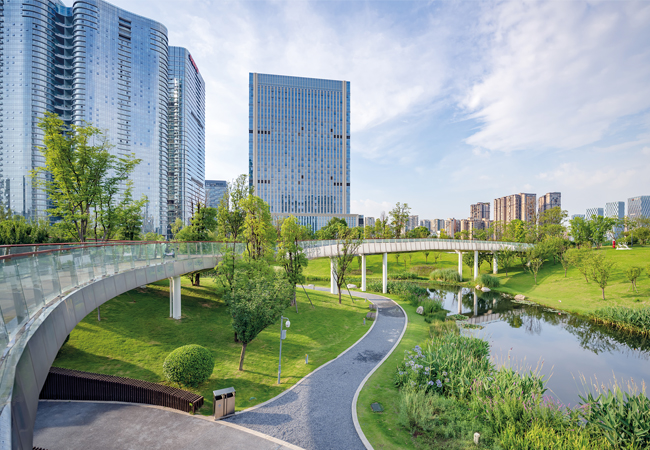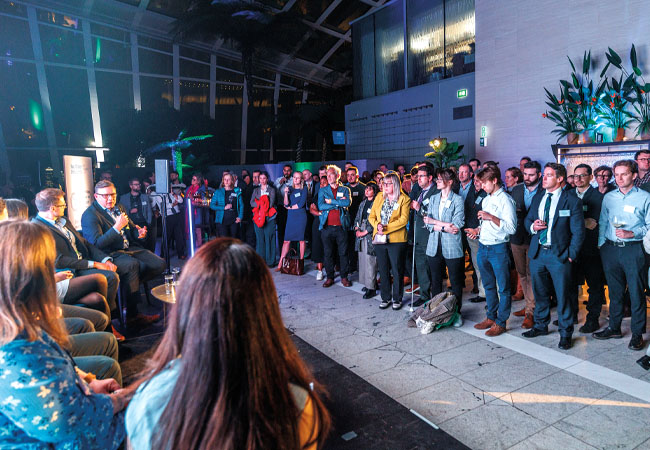
Improving how we manage water in urban landscapes is now more pressing than ever, warns a new white paper from surface-water management specialist Wavin.
The report outlines Wavin’s recommendations for future-proofing infrastructure following an event it staged titled ‘See Water Differently’ in April. The event brought together industry experts to discuss fresh perspectives on water’s pivotal role in urban climate resilience (UCR) with increasing environmental pressures.
The core message of Wavin’s white paper is clear, to future-proof urban infrastructure, cities must embrace a more sustainable approach to water management, including sustainable drainage systems (SuDS). Several practical recommendations are outlined, aiming to provide a clear roadmap to slow or remove the flow of water in traditional (grey) infrastructure systems.
Building services engineers will play a pivotal role in adopting and implementing these solutions.

Wavin’s ‘See Water Differently’ event at London’s Sky Garden
One of the key takeaways of the report is the need for a hybrid approach to water management. The idea is to start with environmental (blue/green) objectives, which are then complemented with grey infrastructure, such as underground drainage pipes, to enhance overall system reliance.
‘Green solutions should play an important role in managing our everyday rainfall and can really complement grey systems by accommodating some of the pressures created by the climate, growing populations, and an ageing asset base,’ said Dr James Webber, lecturer in Water Systems Engineering at the University of Exeter, during the panel discussion.
The consensus was that designs should be green by default as the starting point for any water-management project.
SuDS systems are designed to mimic natural processes by slowing and capturing stormwater to prevent it from overwhelming sewer systems. They include rain gardens, green roofs, tree pits, and permeable paving.
There is huge potential to make our urban environments more resilient
In cities like London, where the population continues to grow and infrastructure ages, SuDS are becoming increasingly critical. London’s sewerage system, which is 150 years old and was built for a population half the size of today’s, is struggling to cope. Research by Thames Water reveals that the number of homes at risk of internal sewer flooding in the city is expected to rise by 54% between 2025 and 2050.
In response to this challenge, Thames Water has adopted a ‘SuDS first’ approach, which prioritises sustainable drainage solutions to help manage surface water.
Intelligent park drainage
In a UK first, Wavin fitted a central London park with its, modular QBic Plus stormwater management system. This gathers and stores stormwater from across the entire site using OsmaDrain pipes and then releases it at a controlled rate via ground infiltration and attenuation tanks connected to the local drainage system. The result is an attractive urban park that always stays dry while taking the pressure off nearby sewers. The system is easy to maintain and can be tailored to a range of sites.
While building new SuDS is essential, the report stresses that retrofitting these systems into dense urban areas is equally vital. However, this can be challenging where space is limited and existing infrastructure is already tightly packed. Nevertheless, the potential benefits are significant, as SuDS can be incorporated into green spaces, parks, and even roadsides to capture and slow water runoff.
A successful example of retrofitting can be seen in Cardiff, the wettest city in the UK. The council transformed a central area into a focal square, with cycle lanes and 200m² of green areas. To tackle significant road runoff, SuDS were implemented in the form of rain gardens and tree pits, customised to support and work around the depth of existing utility pipework and cabling.
To realise the benefit of SuDS, the white paper calls for stronger regulation and policy. In England, the upcoming Schedule 3 of the Flood and Water Management Act 2010 and new Biodiversity Net Gain (BNG) legislation will direct the creation of SuDS. SuDS approval bodies and biodiversity experts will support developers.
However, the report warns that the BNG legislation is not as robust as it could be, as it allows offsite delivery of biodiversity gains, creating the risk that the urban areas most in need of biodiversity improvements may not benefit from SuDS initiatives.
Finding the space in urban areas for new SuDS programmes is challenging, and identifying suitable settings demands lateral thinking and innovative planning. The white paper includes a call to action to engineers across the industry. There’s huge potential to make our urban environments more resilient but, as a society, we need to take action now.
Read the full white paper at bit.ly/SuDSwhitepaper
